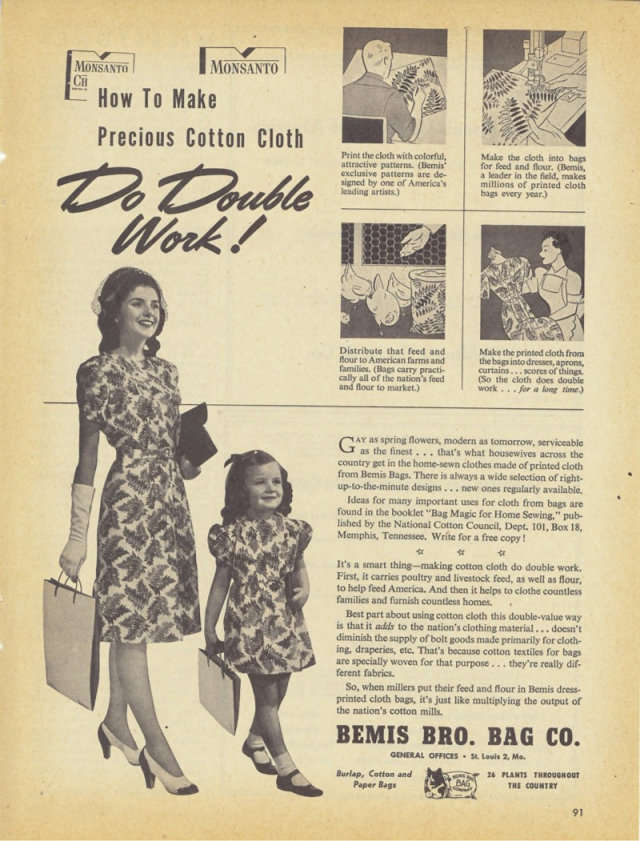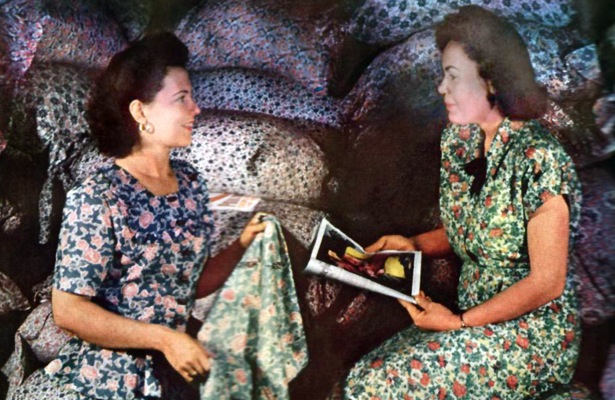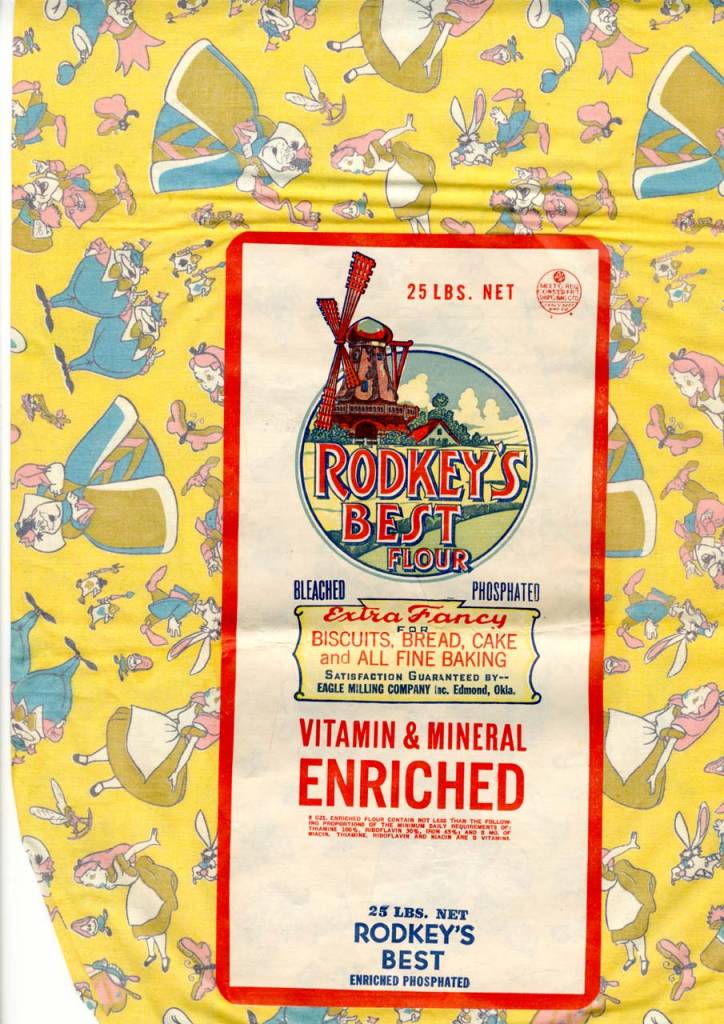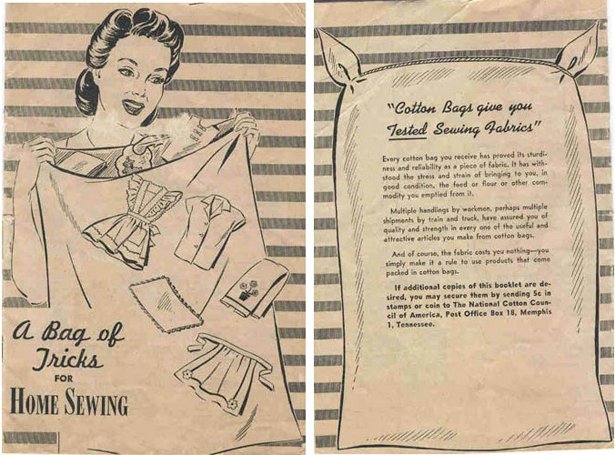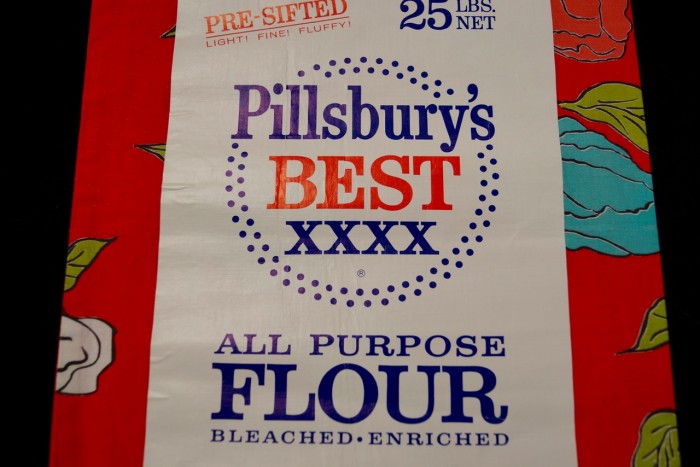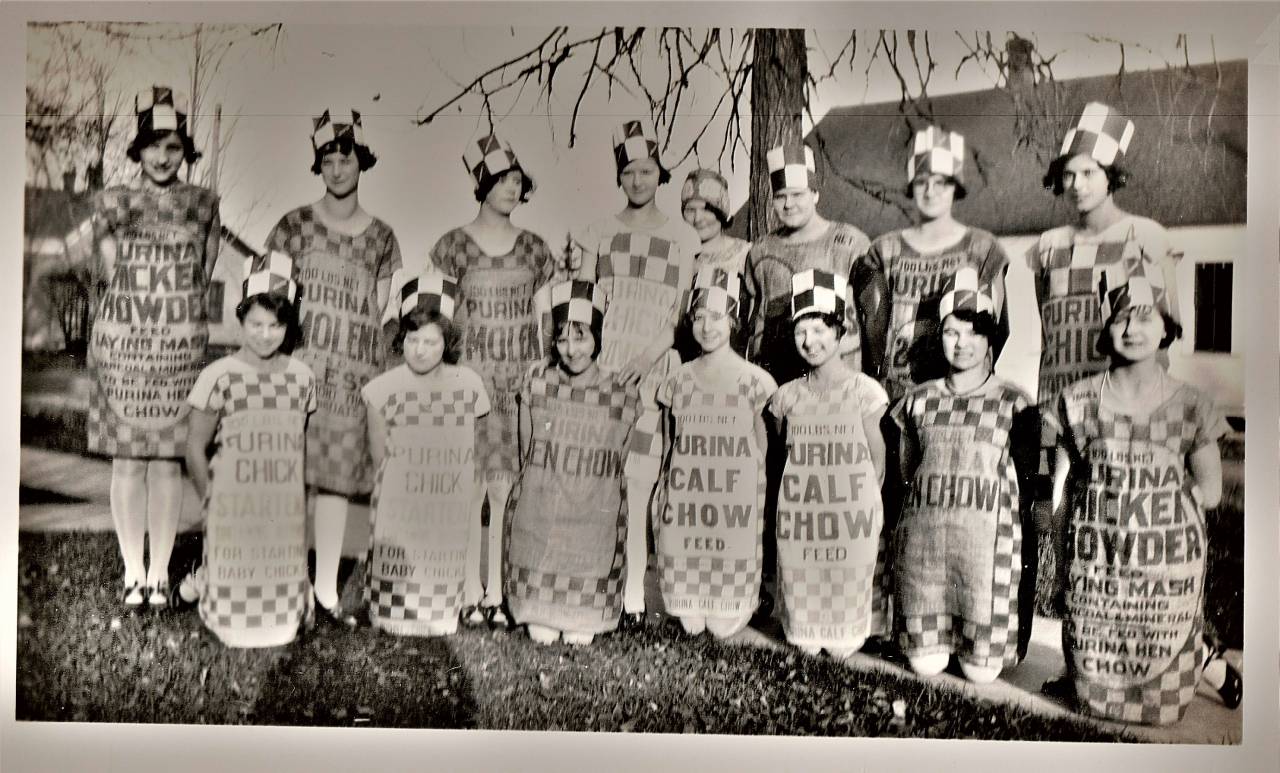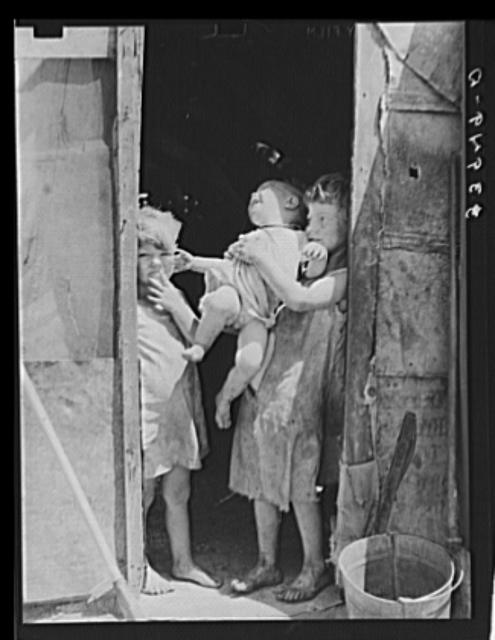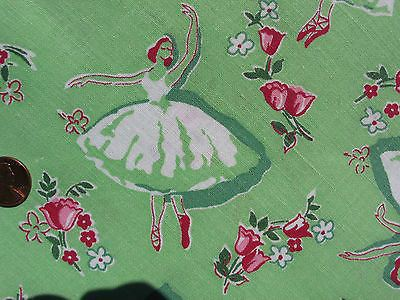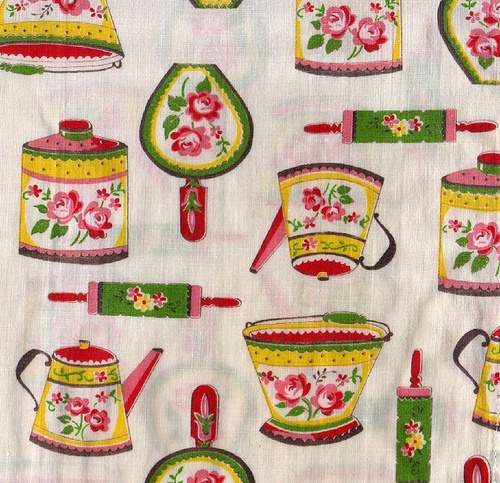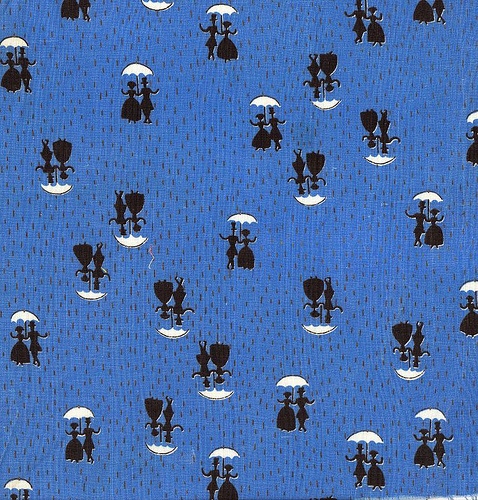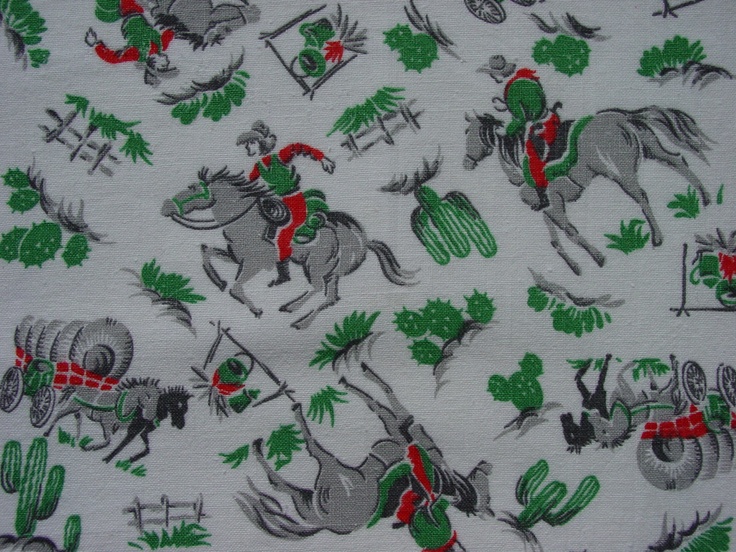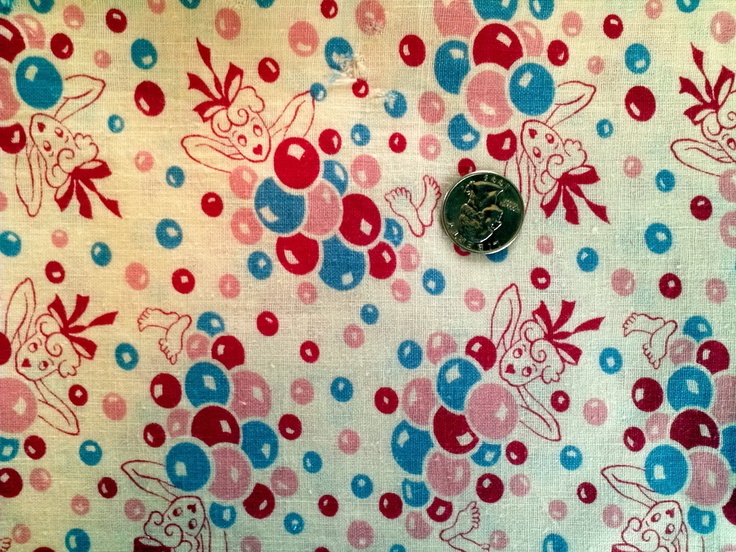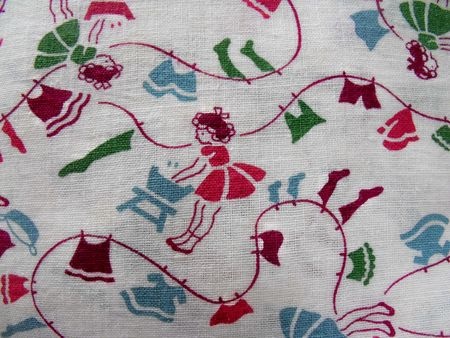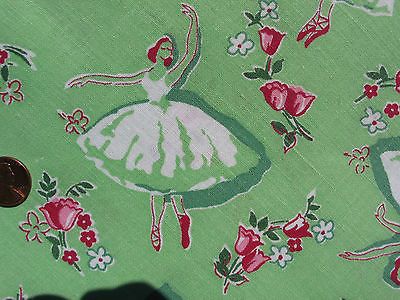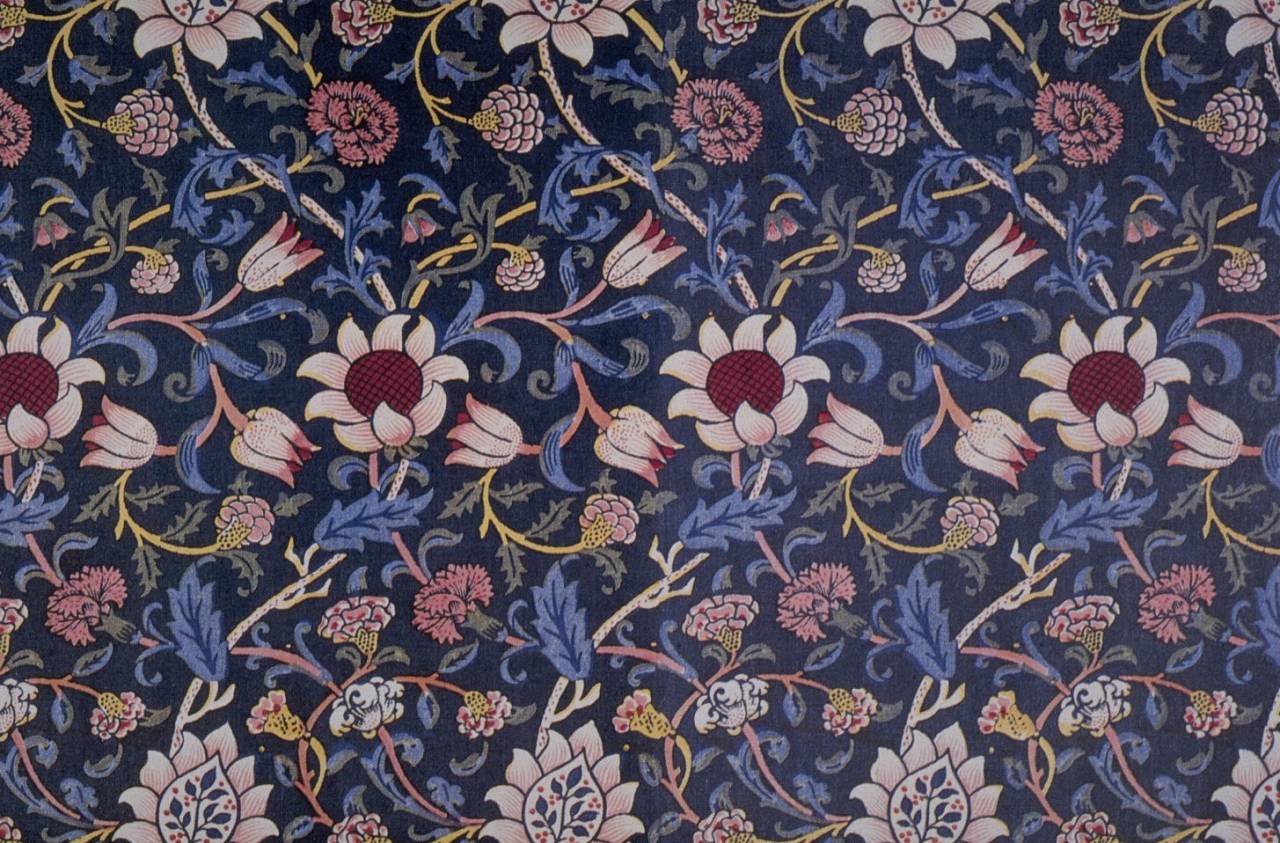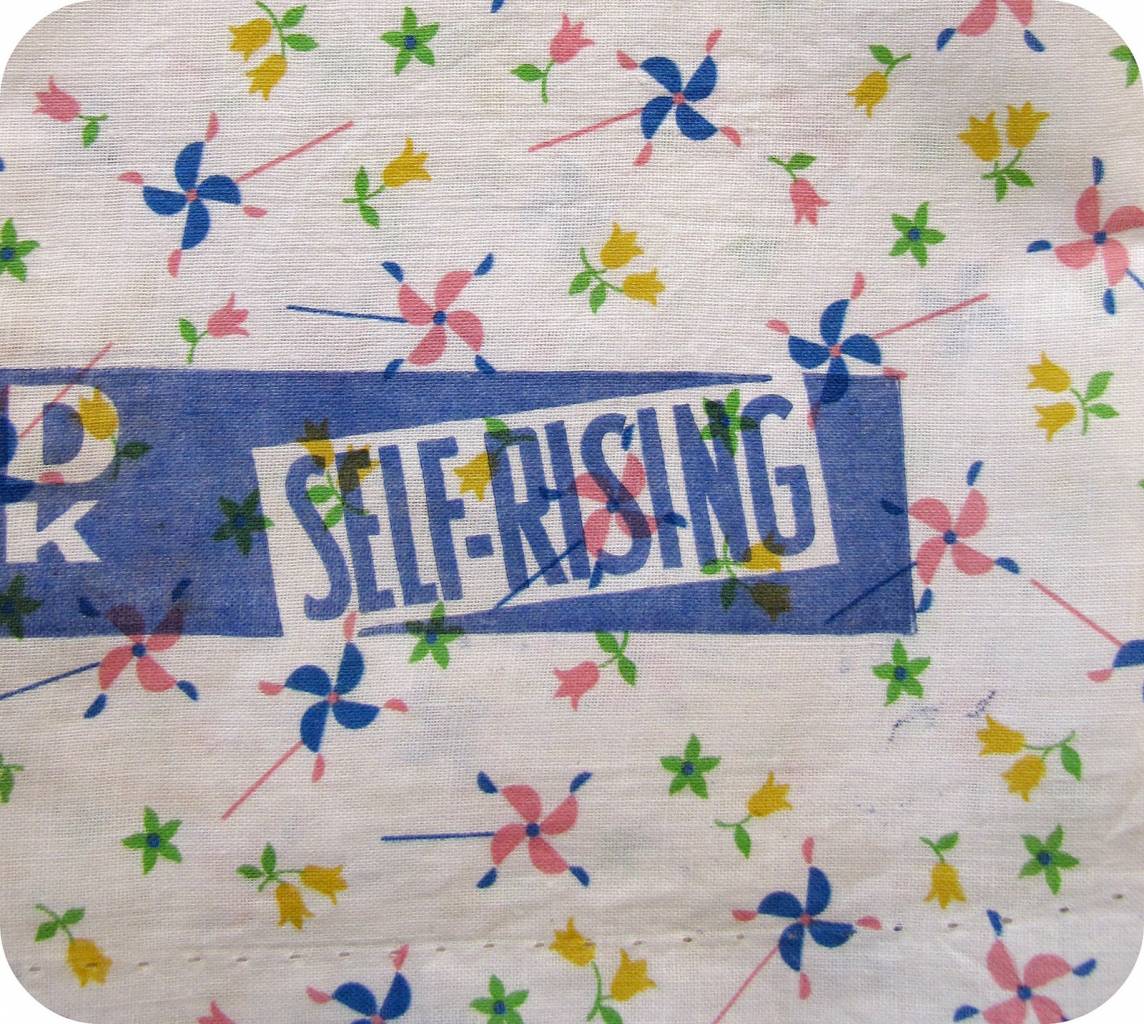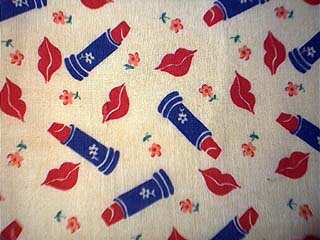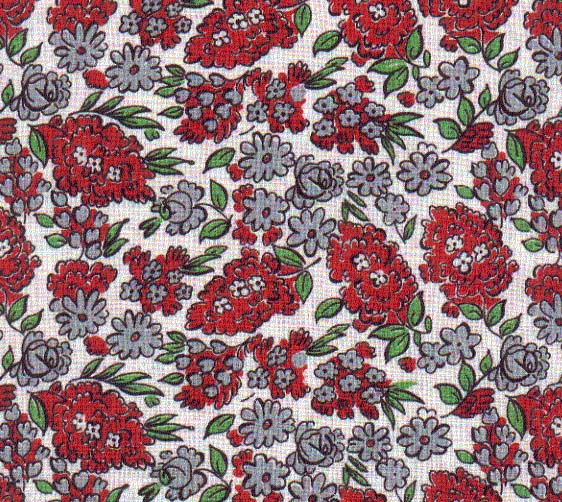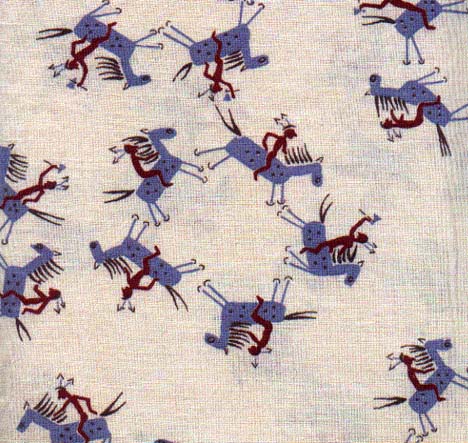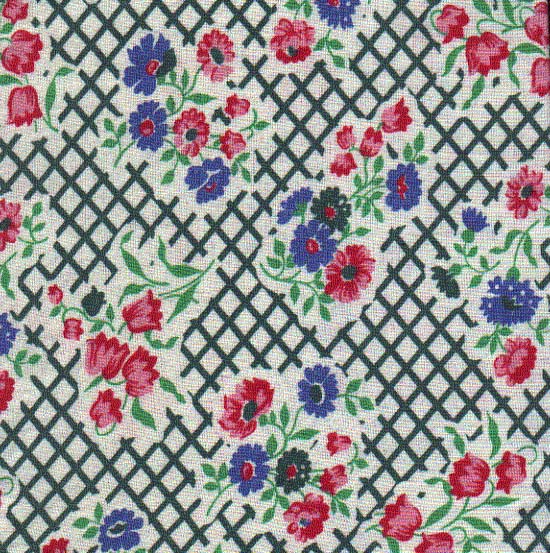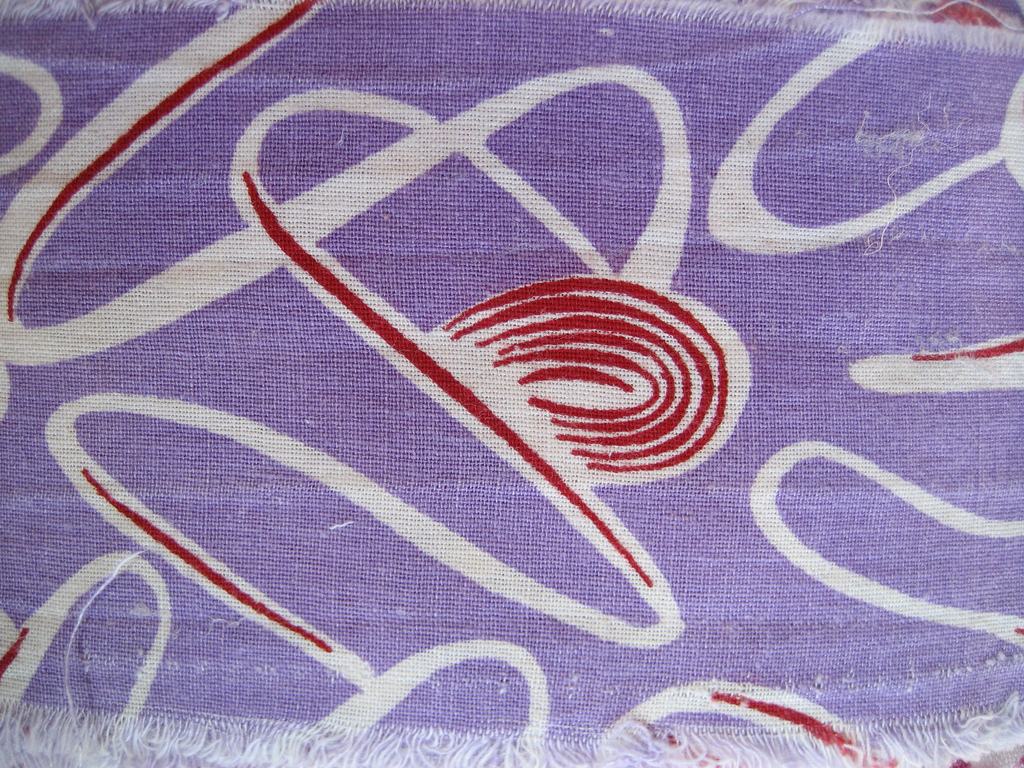Miss Caroline seemed unaware that the ragged, denim-shirted and floursack-skirted first grade, most of whom had chopped cotton and fed hogs from the time they were able to walk, were immune to imaginative literature. Miss Caroline came to the end of the story and said, “Oh, my, wasn’t that nice?”
– To Kill a Mockingbird by Harper Lee
During the Depression people used cotton flour bags and feed sacks to make clothes, curtains, diapers, awnings and other household items. Manufacturers got wind of their bags’ other uses and began decorating them. Color and patterns added a little style and joy to the common sack dress. Of course, it wasn’t all altruistic. As we read in Cotton bags as consumer packages for farm products (1933): ‘One of the greatest opportunities to increase the use of American cotton lies in the field of consumer packaging of farm products…’
In Feed Sack to Clothes Rack: The Use of Commodity Textile Bags in American Households from 1890-1960, we learn much more.
‘Once the fabric was prepared, there was very little difference between a length of feedsack dress percale and a length of dress percale purchased in a store as a new yard good. The Percy Kent Bag Company hired top textile designers from Europe and New York City to create stylish prints with colorfast dyes…
‘In 1927, three yards of dress print cotton percale (the typical amount of fabric needed for an average size adult dress) could cost sixty cents when purchased from the Sears and Roebuck catalog. Three yards of gingham dress goods could cost forty cents. In comparison, three yards of dress quality gingham used in Gingham Girl Flour sacks from the George P. Plant Milling Company could be salvaged after the use of two or three one hundred pound bags of flour.’
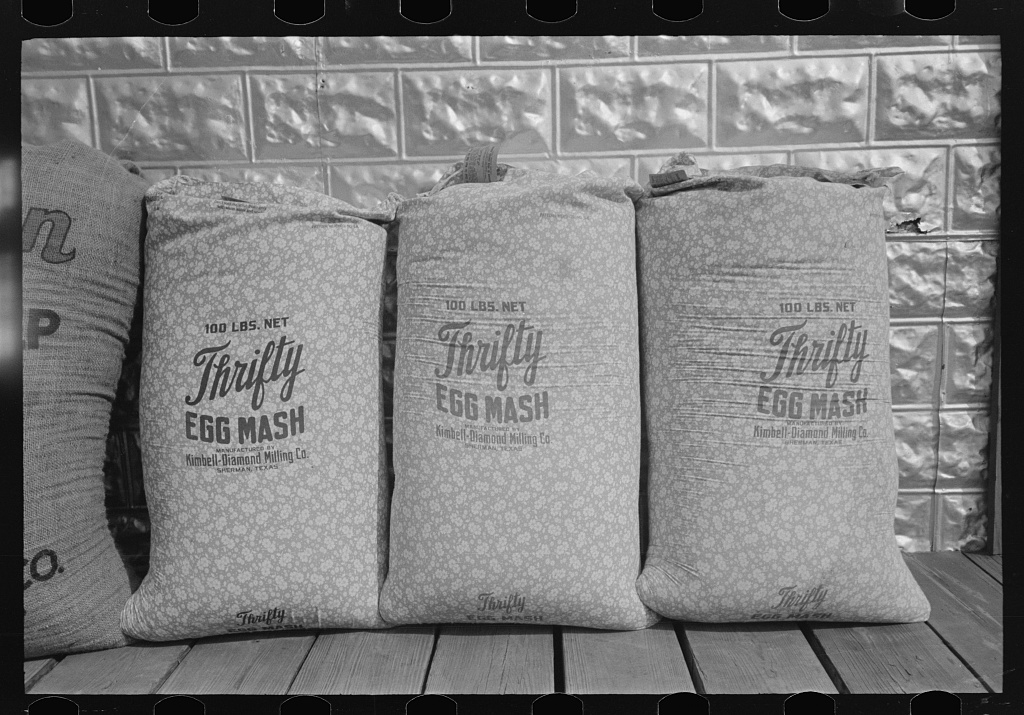
‘Chicken feed, flour and other bulky products are now bagged in printed cotton materials for use as dress materials. Mercedes, Texas
Contributor Names. 1939 Feb.
Those who kept livestock needed more bags.
“We had two big chicken houses and used fourteen sacks of feed every week. My husband got most of the sacks. He always tried to get two or three of the same pattern so we would have enough to make something. He did a pretty good job of picking them out.”
…
‘Feed sacks may have looked like dress fabric, but they were stacked in store piles with little fanfare and employees were surprised by requests to move several hundred pound bags of chicken feed to get to the perfect dress print pattern. One man remembered trips to the feed store as a teenager when it was important to run this errand with several friends because, “his mother’s preferred patterns would always be on the bottom, so he and his “buddies” would have to hoist sacks until they secured the patterns his mother wanted.”…’
‘Feed companies began to notice that while a husband may have little preference in the brand of egg mash fed to his chickens, if his wife needed a specific pattern to match a feed bag that she already owned, her husband began to demonstrate a preference. Suddenly, feed companies were being encouraged to use the latest dress print bags and feed supply stores were turned into fabric stores, to the disdain of one feed salesman interviewed in 1948 who said, “Years ago, they used to ask for all sorts of feeds, special brands you know. Now they come over and ask me if I have an egg mash in a flowered percale. It ain’t natural.”
In the 1950s, though, cheaper paper sacks became available, and thus the gradual decline for these bright, beautiful and functional fabrics began.
The start of the 1960’s saw sack manufacturers trying to tempt customers back with cartoon-printed fabrics, from Buck Rogers to Cinderella. There was even a television advertising campaign intended to prick the conscience of the American housewife, but it failed to generate a significant upsurge in sales. Today it is only the Amish who still use cotton sacks for their dry goods.
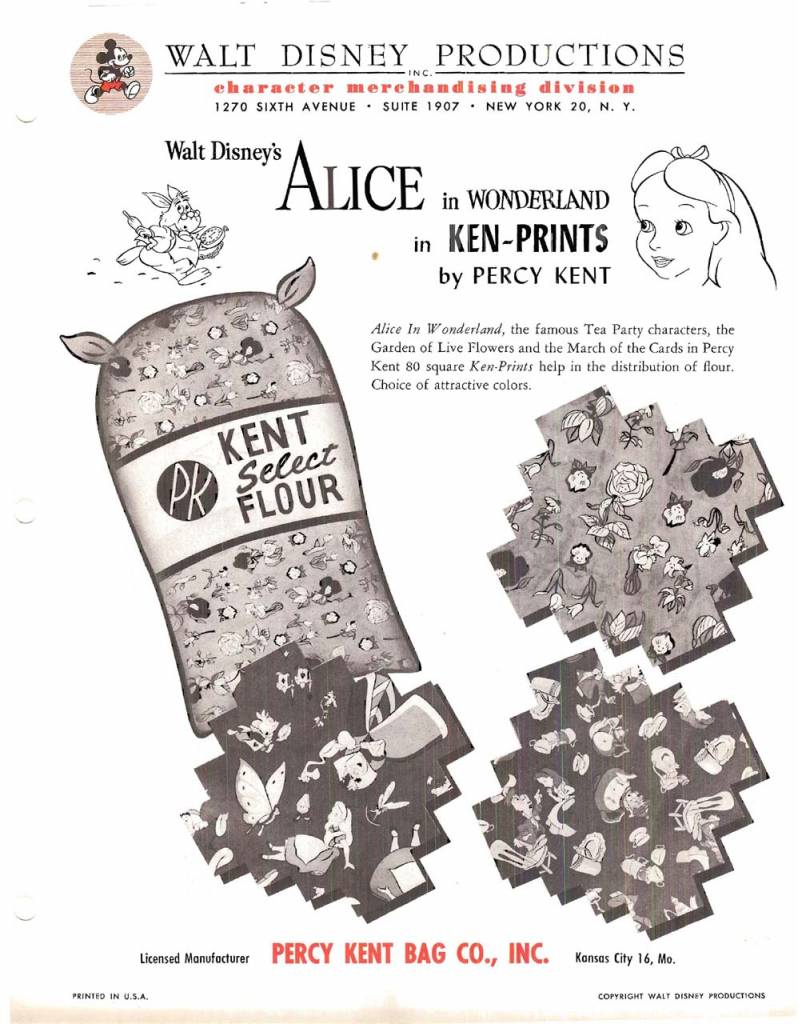
In 1951 Disney licensed the Alice characters for a series of these sacks in 3 patterns: Garden of Live Flowers, March of the Cards, and Mad Tea Party. Via
“It was a different time. People wouldn’t throw stuff away,” says Jessica Faucher, corporate archivist at General Mills. “Washburn Crosby and General Mills saw a need for women – and those in the household – to repurpose flour sacks. Because of the economy, and later in the war efforts, many people could not afford to go buy clothes and had to change their priorities. General Mills really saw a chance to help women utilize not only the flour, but also to use the sack.”
One of the vignettes at the Textile Museum in Englewood, Tennessee includes this quote, “I washed five feed sacks and made me a bedspread.”
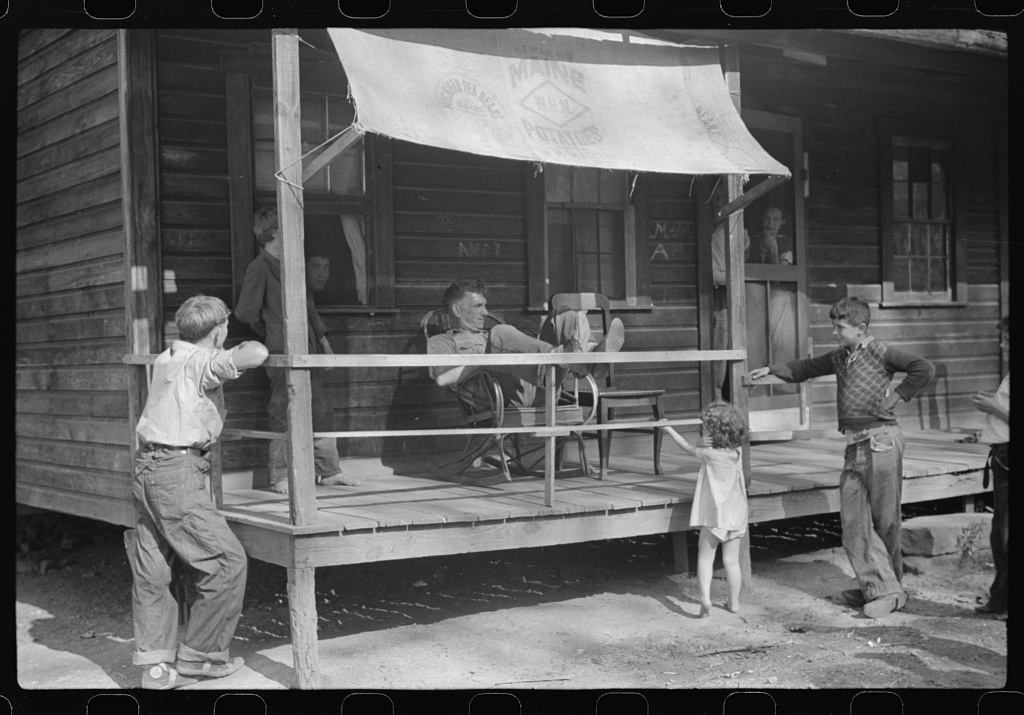
‘Former coal miner sitting on his front porch. He is the town philosopher. He repairs his home (note railing and potato sack awning). Experiments with an elaborate garden on a hill about seven miles away. Jere, Scotts Run, West Virginia.’ 1938 Sept.
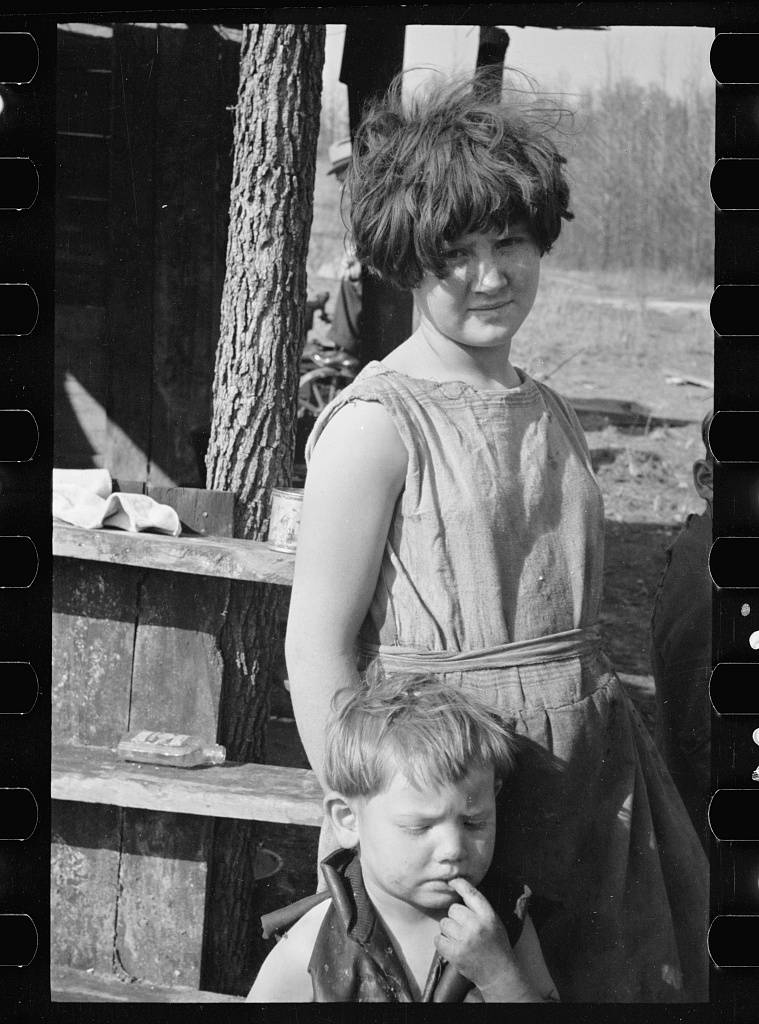
‘Twelve-year old girl of family of nine living in one-room hut built over the chassis of abandoned Ford truck in open field on U.S. Route 70 between Camden and Bruceton, Tennessee. Near backward Tennessee section. The girl is dressed in a meal sack’. 1936 Mar.
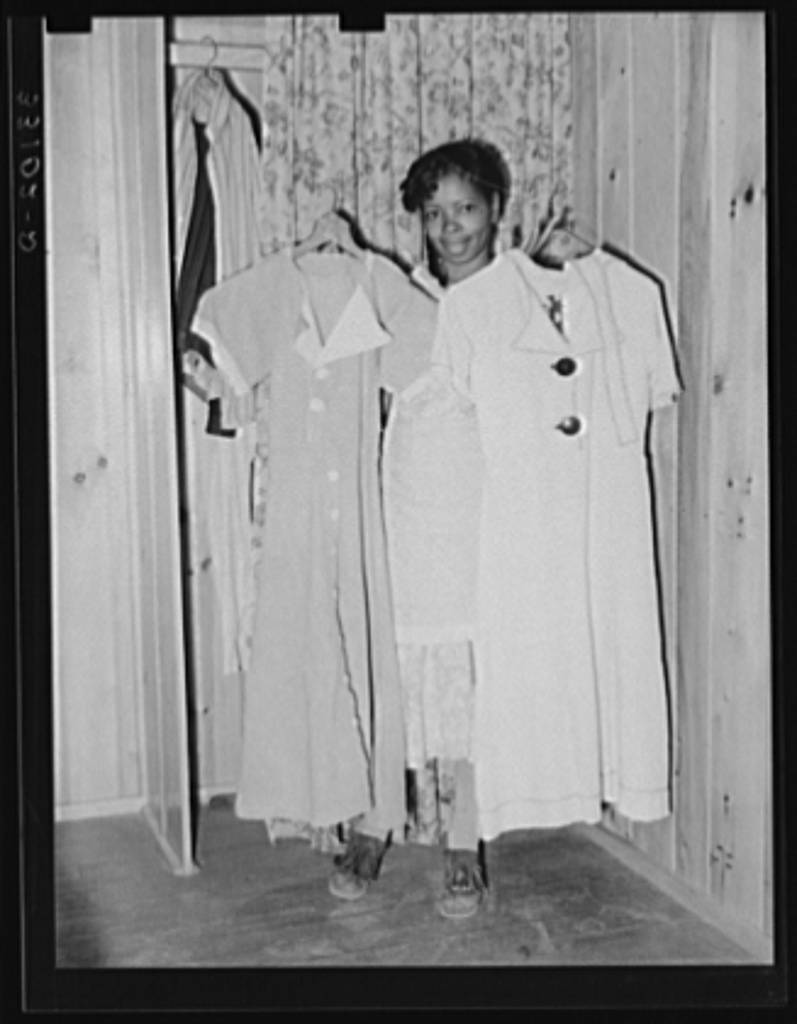
Wife of FSA (Farm Security Administration) client holding dresses which she made from flour sacks. Sabine Farms, Marshall, Texas.Date: 1939
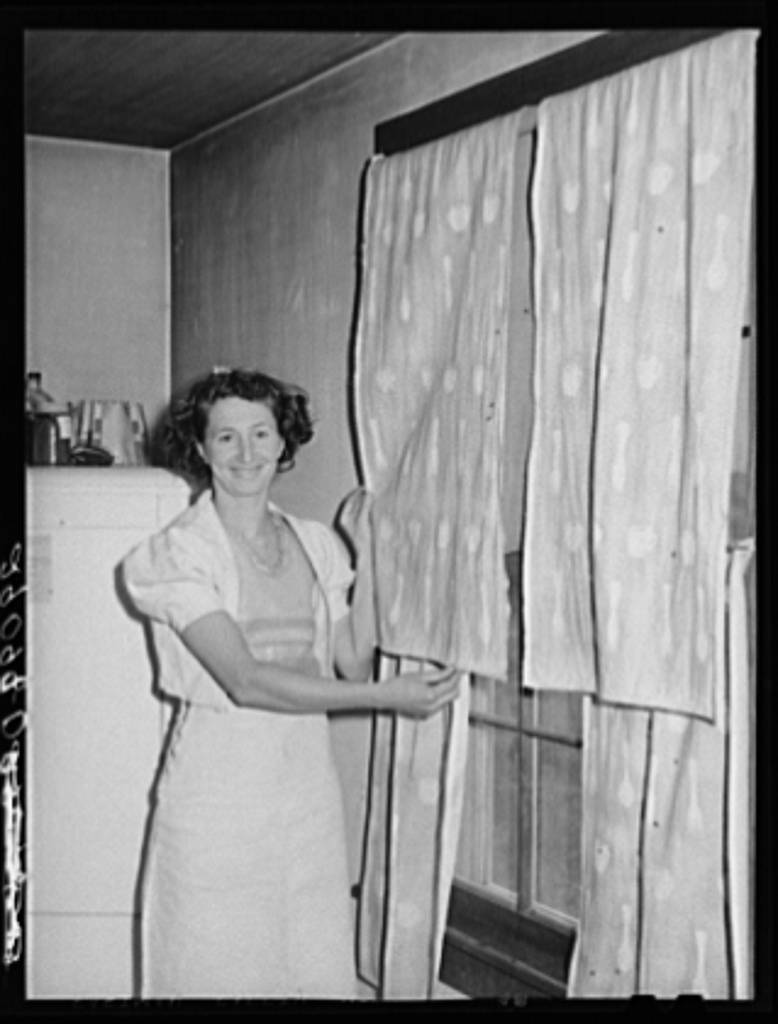
The FSA (Farm Security Administration) home supervisor has helped this woman make her dress of flour sacks and decorate her curtain with splatter work. Osage Farms, Missouri.1939 Nov.
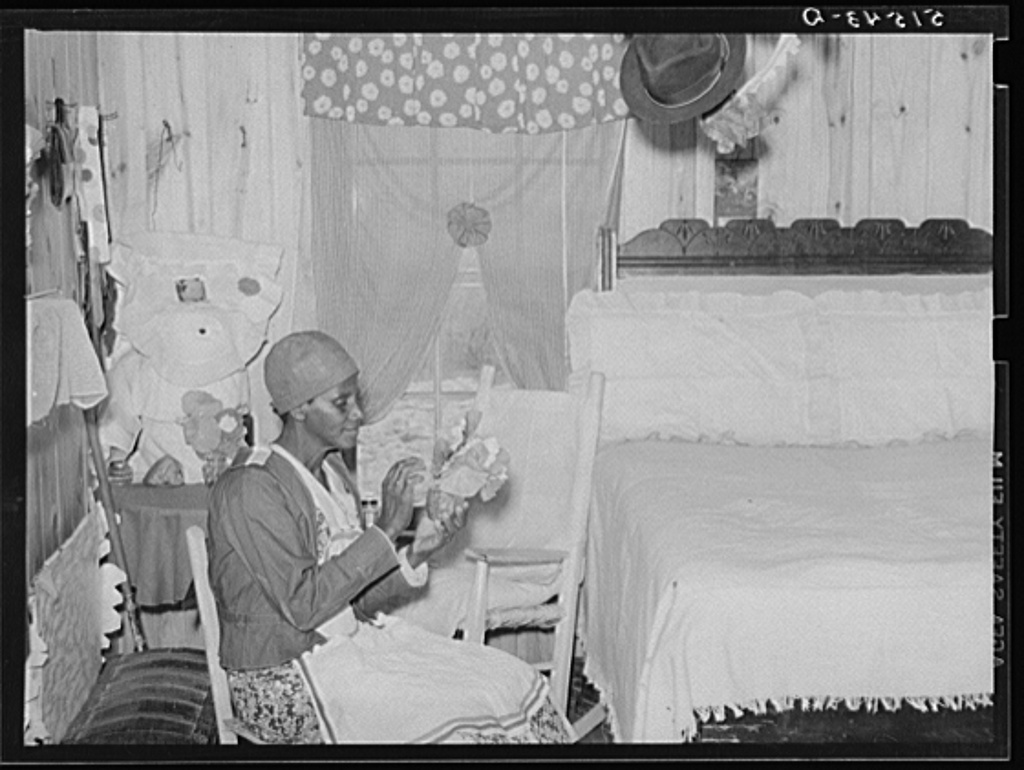
‘Jorena Pettway making flower decorations for her home. She has made practically all her own furniture and her own bedspreads and chair covers from flour sacks, etc. Gee’s Bend, Alabama’.1939 May.

‘Washington, D.C. Modeling blue dress made from sugar sacks worked out for a high school girl on a low income by graduate students of the Deptartment of Clothing and Textiles, School of Home Economics, University of Alabama. Total cost of materials was three dollars and eighteen cents.’ 1940 Summer.

This dress was made by Mrs. G. R. (Dorothy) Overall of Caldwell, Kansas, in 1959 for the Cotton Bag Sewing Contest sponsored by the National Cotton Council and the Textile Bag Manufactureres Association. Via
Hidden fashion history brings things up to date:
A resourceful spirit was the key to a comfortable American household filled with food, clothing and home decorations during the first fifty years of the twentieth century. Looking back with a modern eye, where a finished garment (most likely produced in a developing nation by poorly paid workers) can be purchased from a store at a fraction of the price of its cloth, it is a challenge to put yourself in the place of that rural woman with several family members to clothe, but no budget for store bought clothing or new yard goods to sew these garments at home. For a large portion of lower income families throughout the United States, assistance to expand the family wardrobe came from the commodity cotton bag.
The 1930’s Flour Sack, by Colleen B. Hubert
In that long ago time when things were saved,
when roads were graveled and barrels were staved
and there were no plastic wrap or bags,
and the well and the pump were way out back,
a versatile item, was the flour sack.Pillsbury’s best, mother’s and gold medal, too
stamped their names proudly in purple and blue.
The string sewn on top was pulled and kept
the flour emptied and spills were swept.
The bag was folded and stored in a sack
That durable, practical flour sack.The sack could be filled with feathers and down,
for a pillow, or t’would make a nice sleeping gown.
it could carry a book and be a school bag,
or become a mail sack slung over a nag.
It made a very convenient pack,
That adaptable, cotton flour sack.Bleached and sewn, it was dutifully worn
as bibs, diapers, or kerchief adorned.
It was made into skirts, blouses and slips.
And mom braided rugs from one hundred strips
she made ruffled curtains for the house or shack,
from that humble but treasured flour sack!As a strainer for milk or apple juice,
to wave men in, it was a very good use,
as a sling for a sprained wrist or a break,
to help mother roll up a jelly cake,
as a window shade or to stuff a crack,
we used a sturdy, common flour sack!As dish towels, embroidered or not,
they covered up dough, helped pass pans so hot,
tied up dishes for neighbors in need,
and for men out in the field to seed.
They dried dishes from pan, not rack
that absorbent, handy flour sack!We polished and cleaned stove and table,
scoured and scrubbed from cellar to gable,
we dusted the bureau and oak bed post,
made costumes for October (a scary ghost)
and a parachute for a cat named jack.
From that lowly, useful old flour sack!So now my friends, when they ask you
As curious youngsters often do,
“before plastic wrap, elmers glue
and paper towels, what did you do?”
tell them loudly and with pride don’t lack,
“grandmother had that wonderful flour sack!”
Via AmeriPics, ChariseCreates, GoodBuyAnnies, Handmaiden
Would you like to support Flashbak?
Please consider making a donation to our site. We don't want to rely on ads to bring you the best of visual culture. You can also support us by signing up to our Mailing List. And you can also follow us on Facebook, Instagram and Twitter. For great art and culture delivered to your door, visit our shop.


